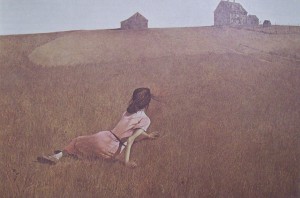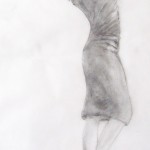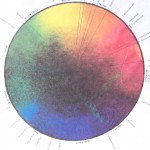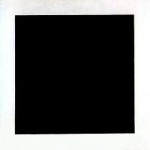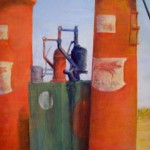An artist often wonders what inspired him/her to draw and paint the way they do, their styles, art movements and isms, or that one particular artist living or dead. I personally go back in my past and wonder. I have such a passion for all good art; it might be a particular painting or style that grips me. Oddly, I find that I like art from most all the movements. Although, my main inspiration for my own work is in a more realistic vein, there are some abstracts that totally blow me away.

One of my inspirational artists was Andrew Wyeth. I read once where he said that he did not consider himself a realistic artist but an abstract artist (taken from memory not a direct quote). Looking at the old photograph of an old photograph at the right, you can certainly see the abstract elements in his artwork and understand why he might say this. This is a representation for information only and is not in any way to properly depict the quality of the painting or its value. I’ve loved the delicate artwork of Andrew Wyeth for as long as I remember…and that goes back to the mid 1950s of this past century. In other words, a long time ago.
 I’d feel derelict in my duties to this blog not to mention that one of my all time inspirations was the famous illustrator (and I consider “fine artist”), Norman Rockwell. I remember as a young man, I waited with bated breath for the newest and latest issue of the Saturday Evening Post so I could see Rockwell’s most recent creation. It wasn’t long after my mother relinquished the magazine that I had my sketchpad out and was trying to draw the images before my excited eyes. To me, Rockwell was as great an artist as Rembrandt Harmenszoon van Rijn. I don’t think I’ve changed my mind since then. Rockwell portrayed the century of the common man, which was deeply American. He also presented the wife of the common man, his children, his pastor, his doctor, his garage mechanic, his banker, his druggist, his grocer, his barber, his dog his neighbor and much much more. In other words, I related to him.
I’d feel derelict in my duties to this blog not to mention that one of my all time inspirations was the famous illustrator (and I consider “fine artist”), Norman Rockwell. I remember as a young man, I waited with bated breath for the newest and latest issue of the Saturday Evening Post so I could see Rockwell’s most recent creation. It wasn’t long after my mother relinquished the magazine that I had my sketchpad out and was trying to draw the images before my excited eyes. To me, Rockwell was as great an artist as Rembrandt Harmenszoon van Rijn. I don’t think I’ve changed my mind since then. Rockwell portrayed the century of the common man, which was deeply American. He also presented the wife of the common man, his children, his pastor, his doctor, his garage mechanic, his banker, his druggist, his grocer, his barber, his dog his neighbor and much much more. In other words, I related to him.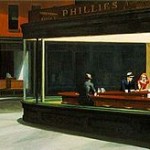
What can I say about Edward Hopper? For many years, I’ve kept Hopper’s painting, Nighthawks, as a screen saver on my computer. Much of my life I spent traveling on business trips. Often, I would go late night to a lonely diner. The scene depicted in Nighthawks was very touching to me. It was as if the man with his back to the viewer was me. In many instances Hopper told a story in his paintings and it creates an emotion. Isn’t that what an artist is supposed to do?
Hopper liked to paint trains that seemed as if they were creeping through an industrial side of a city. I like trains. Recently, I’ve thought of creating a painting with a train slowly crawling along the tracks amidst an industrial area and the view point of the visitors looking at the painting would be as if they were standing near a railroad crossing sign. The bulk of the painting is the boxcar of the train where a street artist has painted on the entire side of the car an abstraction closely resembling Wassily Kandinsky’s Composition VII . It’s funny how an arist’s mind works. I told you I like abstract. Perhaps I didn’t explain myself well enough. I can’t really do original abstract painting and am truly jealous of those that can–that is, if they’re any good.
. It’s funny how an arist’s mind works. I told you I like abstract. Perhaps I didn’t explain myself well enough. I can’t really do original abstract painting and am truly jealous of those that can–that is, if they’re any good. If it grips me, then they’re good.
If it grips me, then they’re good.
Another of my inspirations was Thomas Hart Benton. He was a man of complex character with a volatile personality, but there was little doubt to his commitment to art. He was considered the great recorder of the American scene. He was another realistically painting artist that used a lot of abstraction in his paintings and was even Jackson Pollock’s art teacher (the famous abstract impressionist artist). As a matter of fact, Benton ventured off into abstraction for a while (see the picture above), only to go back to a more realistic style of painting.
He was considered the great recorder of the American scene. He was another realistically painting artist that used a lot of abstraction in his paintings and was even Jackson Pollock’s art teacher (the famous abstract impressionist artist). As a matter of fact, Benton ventured off into abstraction for a while (see the picture above), only to go back to a more realistic style of painting.
I visit a lot of today’s artist sights and gallery exhibitions, and can not show their work on this sight without their permission, but some are fantastic and every much as inspiring as those considered famous or the ones I’ve mentioned above.
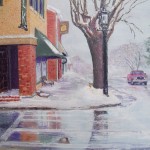
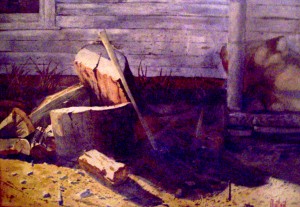



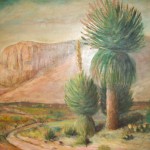
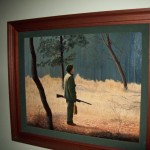

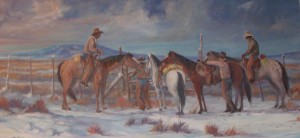
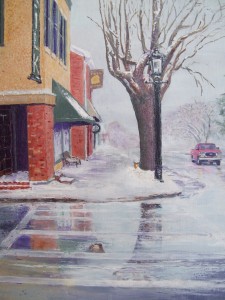
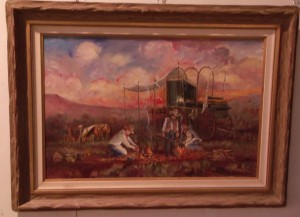
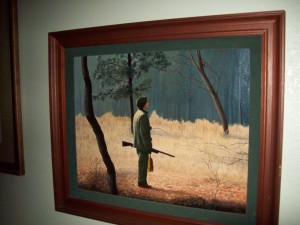
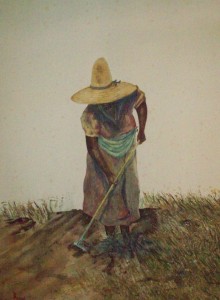
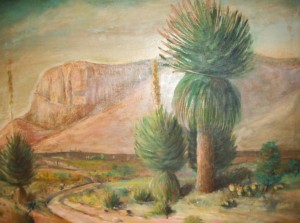

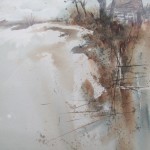




 I’d feel derelict in my duties to this blog not to mention that one of my all time inspirations was the famous illustrator (and I consider “fine artist”), Norman Rockwell. I remember as a young man, I waited with bated breath for the newest and latest issue of the Saturday Evening Post so I could see Rockwell’s most recent creation. It wasn’t long after my mother relinquished the magazine that I had my sketchpad out and was trying to draw the images before my excited eyes. To me, Rockwell was as great an artist as Rembrandt Harmenszoon van Rijn. I don’t think I’ve changed my mind since then. Rockwell portrayed the century of the common man, which was deeply American. He also presented the wife of the common man, his children, his pastor, his doctor, his garage mechanic, his banker, his druggist, his grocer, his barber, his dog his neighbor and much much more. In other words, I related to him.
I’d feel derelict in my duties to this blog not to mention that one of my all time inspirations was the famous illustrator (and I consider “fine artist”), Norman Rockwell. I remember as a young man, I waited with bated breath for the newest and latest issue of the Saturday Evening Post so I could see Rockwell’s most recent creation. It wasn’t long after my mother relinquished the magazine that I had my sketchpad out and was trying to draw the images before my excited eyes. To me, Rockwell was as great an artist as Rembrandt Harmenszoon van Rijn. I don’t think I’ve changed my mind since then. Rockwell portrayed the century of the common man, which was deeply American. He also presented the wife of the common man, his children, his pastor, his doctor, his garage mechanic, his banker, his druggist, his grocer, his barber, his dog his neighbor and much much more. In other words, I related to him.
 . It’s funny how an arist’s mind works. I told you I like abstract. Perhaps I didn’t explain myself well enough. I can’t really do original abstract painting and am truly jealous of those that can–that is, if they’re any good.
. It’s funny how an arist’s mind works. I told you I like abstract. Perhaps I didn’t explain myself well enough. I can’t really do original abstract painting and am truly jealous of those that can–that is, if they’re any good.
 He was considered the great recorder of the American scene. He was another realistically painting artist that used a lot of abstraction in his paintings and was even Jackson Pollock’s art teacher (the famous abstract impressionist artist). As a matter of fact, Benton ventured off into abstraction for a while (see the picture above), only to go back to a more realistic style of painting.
He was considered the great recorder of the American scene. He was another realistically painting artist that used a lot of abstraction in his paintings and was even Jackson Pollock’s art teacher (the famous abstract impressionist artist). As a matter of fact, Benton ventured off into abstraction for a while (see the picture above), only to go back to a more realistic style of painting.